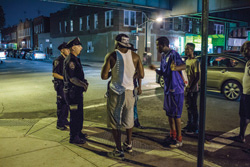Has ‘stop and frisk’ been stopped?

Though many New Yorkers credited aggressive police tactics for a sharp reduction in street crime, policies like stop-and-frisk proved immensely unpopular in the city’s poorest precincts. In one eight-block area of Brooklyn, police made nearly 52,000 stops over a four-year period, resulting in a limited number of arrests. ©Kevin Downs/Demotix/Corbis
In the new, gentrified post-9/11 New York City, gone are the days when a visitor’s trip to Times Square might include aggressive panhandling, a mugging or an uncomfortable exchange with a prostitute. But gone, too, are $900 apartments in the East Village, Soho artists lofts that artists can actually afford and $150-a-night hotel rooms that have their own bathroom.
In one of the signature achievements of Michael Bloomberg’s three terms as mayor, New York police helped create a new quality of life for many New Yorkers—even the poorest—through a sometimes merciless attention to low-level crimes like public intoxication, littering, graffiti, loitering and petty property crimes.
The policy grew from a statistics-driven program adopted in 1994 called CompStat, and was propelled by a crack-fueled crime surge that threatened to undermine the city’s reputation as the global epicenter of social democracy and cultural tolerance. By focusing on offenses that were offensive at the neighborhood level, police helped disperse concentrations of criminal behavior that were breeding more serious and more violent crimes.
By almost any standard, CompStat has been successful. Since 1990, murders have dropped 85.2 percent, rapes by more than half. Burglaries are down 85.7 percent and robberies are down 80 percent. Statisticians and criminologists are sometimes divided in their perceptions of the turnaround—citing changing demographics, stiffened sentencing, even the social effects of gentrification—but nearly all concede that CompStat’s concentrated enforcement policies have played a significant role.
Click here to read the rest of “Stopping stop and frisk” from the March issue of the ABA Journal.



